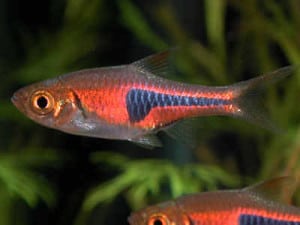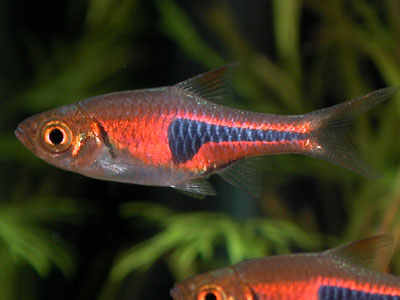
Common name: Rasbora, Harlequin Rasbora, Red Rasbora, Harlequin Fish
Scientific name: Trigonostigma Heteromorpha
Common name: Rasbora, Harlequin Rasbora, Red Rasbora, Harlequin Fish
Scientific name: Trigonostigma Heteromorpha
Average Adult Fish Size: 1.75 inches / 5 cm
Place of Origin: Rivers and streams of Thailand, Eastern Sumatra and the Malaysian Peninsula
Typical Tank setup: A well planted tank with rocks, bogwood/driftwood that has a moderate current is best.
Recommended Minimum Aquarium Capacity: 10 gallon / 40 litre
Compatibility: Rasboras are a peaceful species and do very well in community aquariums with other peaceful fish of similar size. They do best if kept in schools of 8 or more.
Temperature: 73 – 82 Deg F / 22 – 25 Deg C
Water chemistry: pH 5.0- 7.0
Feeding: They are omnivorous and do best on a varied diet of quality flake foods, micro pellets, daphnia, brine shrimp, and microworms.
Sexing: The Rasbora can be hard to sex but the females are usually a little bit larger and rounder than the males. The males are usually smaller and more slender. It is however hard to say for sure using this method. What looks like a male can be a small unconditioned female and what look like a female can be a fat male.
Breeding: The Rasbora is a hard species to breed. It requires very soft acidic water. The water hardness should not be higher than 1.5 to 2.5 (4) DH when trying to breed this species. The pH-value should be kept around 6.0 and the temperature at 82 Deg F / 28 Deg C . Using tea colored water caused by tannins from driftwood/bogwood or peat is suggested along with lighting that is not too bright.
Unlike many other rasbora species the Harlequin Rasbora is not an egg-scatterer; it will deposit its eggs on the underside of a broad leaf. In the wild it is usually a cryptocoryne leaf. The spawning usually takes a long time and they might spawn for days before mating finally takes place. The eggs are deposited 6-12 at a time and a total of up to 300 eggs can be deposited. A typical mating results in 80-100 eggs. Once fertilization has taken place you will need to remove the parents as they will eat their own eggs and fry.
When the parents have been removed the water level should be lowered to 10-15 cm (4-6 inches), unless this would put any eggs above the water line. Harlequin Rasbora eggs hatch after 18-36 hours and the offspring will become free swimming 3-5 days after that. The fry are 3 to 4 millimetres long and need to be feed infusorians or other small food. They will be large enough to accept newly hatched brine shrimp after 7-14 days. The fry grows rather quickly, much quicker than many other rasbora species. The fry will look like miniature adults after 8-10 weeks.
Additional Information: There are three common variations of this species in the trade: the normal wild type, the black type and the golden type. The average lifespan if well cared for is 5-6 years. Just like many other rasbora species, the Harlequin Rasbora prefers dimmed light and a few floating plants on the surface in the open area is therefore a good idea. A dark bottom substrate is recommended.1.75 inches / 5 cm
Place of Origin: Rivers and streams of Thailand, Eastern Sumatra and the Malaysian Peninsula
Typical Tank setup: A well planted tank with rocks, bogwood/driftwood that has a moderate current is best.
Recommended Minimum Aquarium Capacity: 10 gallon / 40 litre
Compatibility: Rasboras are a peaceful species and do very well in community aquariums with other peaceful fish of similar size. They do best if kept in schools of 8 or more.
Temperature: 73 – 82 Deg F / 22 – 25 Deg C
Water chemistry: pH 5.0- 7.0
Feeding: They are omnivorous and do best on a varied diet of quality flake foods, micro pellets, daphnia, brine shrimp, and microworms.
Sexing: The Rasbora can be hard to sex but the females are usually a little bit larger and rounder than the males. The males are usually smaller and more slender. It is however hard to say for sure using this method. What looks like a male can be a small unconditioned female and what look like a female can be a fat male.
Breeding: The Rasbora is a hard species to breed. It requires very soft acidic water. The water hardness should not be higher than 1.5 to 2.5 (4) DH when trying to breed this species. The pH-value should be kept around 6.0 and the temperature at 82 Deg F / 28 Deg C . Using tea colored water caused by tannins from driftwood/bogwood or peat is suggested along with lighting that is not too bright.
Unlike many other rasbora species the Harlequin Rasbora is not an egg-scatterer; it will deposit its eggs on the underside of a broad leaf. In the wild it is usually a cryptocoryne leaf. The spawning usually takes a long time and they might spawn for days before mating finally takes place. The eggs are deposited 6-12 at a time and a total of up to 300 eggs can be deposited. A typical mating results in 80-100 eggs. Once fertilization has taken place you will need to remove the parents as they will eat their own eggs and fry.
When the parents have been removed the water level should be lowered to 10-15 cm (4-6 inches), unless this would put any eggs above the water line. Harlequin Rasbora eggs hatch after 18-36 hours and the offspring will become free swimming 3-5 days after that. The fry are 3 to 4 millimetres long and need to be feed infusorians or other small food. They will be large enough to accept newly hatched brine shrimp after 7-14 days. The fry grows rather quickly, much quicker than many other rasbora species. The fry will look like miniature adults after 8-10 weeks.
Additional Information: There are three common variations of this species in the trade: the normal wild type, the black type and the golden type. The average lifespan if well cared for is 5-6 years. Just like many other rasbora species, the Harlequin Rasbora prefers dimmed light and a few floating plants on the surface in the open area is therefore a good idea. A dark bottom substrate is recommended.


Related Posts
Croaking Gourami – Trichopsis vittatus
Benthochromis Tricoti
Large-eyed Mouthbrooder – Callochromis Macrops